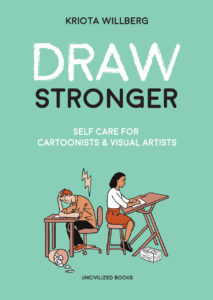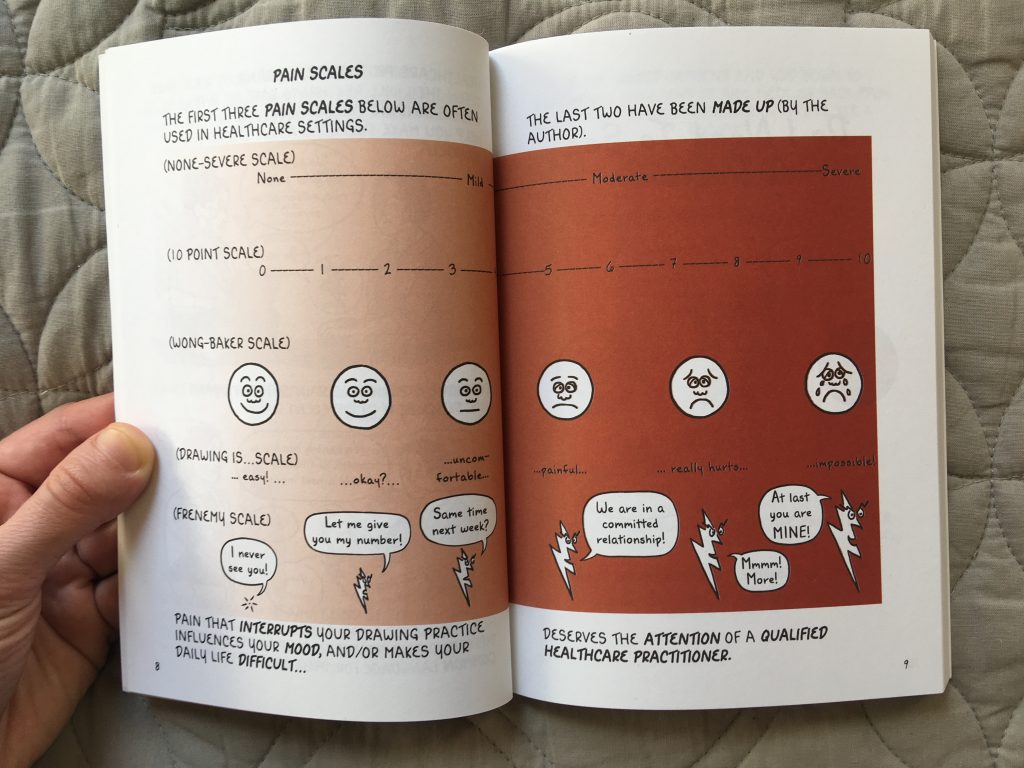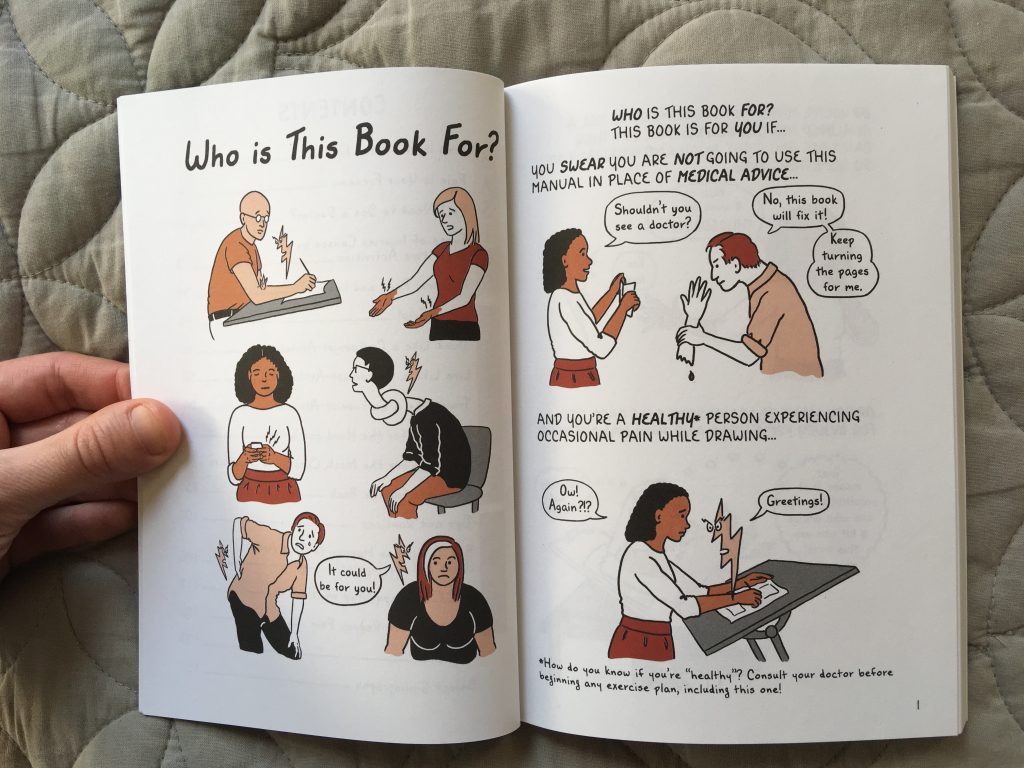Reviewed by Sara Sarmiento.
A particular gripe of mine for several years now has been how little we as a society tend to know about our bodies until we have injured ourselves. I can’t tell you how many conversations I’ve had with friends where we talk about how we wish we knew all the things we know now before we hurt ourselves, but know that we would never have learned the things we’ve learned if we hadn’t injured ourselves. So, while I was already excited for the release of Draw Stronger, I was thrilled to hear Kriota Willberg talk on a panel at MoCCA about wanting to get people involved with their bodies, preferably before we get sick or injured.
I’ve been in a slow recovery for years from a shoulder injury sustained during a couple hard falls on ice and hit the point not long ago where I had to admit to myself that I didn’t have the tools to heal any more on my own. In conjunction with that, following the completion of my submission for the 2017 Comics Workbook Composition Competition, my wrist and hand pain associated with drawing I’d experienced for years had shifted from a mild annoyance to pain shooting up my forearm. It was curtailing both my ability to draw, and the swing dance habit I’d developed in the last year. A few months into the forearm pain, my thumb started twitching. While it’s a good party trick to get people to hold my hand, the twitch needed to go.
Starting physical therapy in January was an immensely good decision for me, physically and mentally. I’d been left disheartened after completing my CWCC comic. How am I supposed to start shifting creative pursuits into my primary gig when I can’t finish a personal project without spending months in recovery? One of my big goals coming into therapy was to set me on the path towards being able to draw for extended periods of time. Physical therapy got me going on that path, but from past experiences in PT, I know that you’re not fixed and done the moment you are discharged. I was nervous about nearing the end of my PT sessions, so the release of Kriota Willberg’s new book Draw Stronger couldn’t have been better timed.
I’ve been familiar with Kriota’s work for years. I’ve always been immensely disappointed that our time at the Center for Cartoon Studies did not coincide, but now I have a whole book by her! A massage therapist and health science educator of many years, not to mention a dancer, Kriota is more than qualified to be talking about anatomy. You know that saying, undressing someone with your eyes? Kriota likes to say that she can actually undress you and then flay you. Kriota has her own particular sense of humor, and no fear of getting gruesome. On the flip side of that, she admits that there are plenty of people that can’t get past their discomfort to engage with her work.
However, while a lot of her more personal work can get a little grizzly, she scales it back in Draw Stronger. I’m not very squeamish myself, so I may not be the best judge of this, but think the average person will be able to pick up Draw Stronger without feeling queasy.
Draw Stronger covers a lot of ground in a compact little package. It starts with an overview explaining pain, injuries and where they come from. It then moves on to give you instructions for warm ups, exercises and stretches to do for all the muscles you use while drawing. Importantly, it has clear instructions on how to do things properly so you are getting the most out of any given exercise without hurting yourself. It also has a nice section with recommended combinations of routines, helping you start putting things together in the bigger picture of your life, though it does require you to flip back and forth from the pages with lists of suggested routines to the pages with the actual instructions. The last part of the book concerns first aid if you have already started experiencing pain.
Draw Stronger is a fast read, but well presented. The information is easy to understand and engaging. While it’s science, health and anatomy, it’s by no means dry or difficult to read. Kriota’s sense of humor really shines through here. She goes for a lot of visual puns that are as entertaining as they are helpful in illustrating concepts. Her chart for explaining pain scales is one of the most helpful pain charts I’ve seen. An incredibly subjective experience, pain is notoriously difficult for patients to describe to their caregivers.
I appreciate the realistic tone of the book. It acknowledges that sometimes you have to keep working even when you are in pain.. While issuing warnings, it also gives advice on how to keep working while minimizing risk of further damage.
This book would also be useful to plenty of people that aren’t strictly speaking artists: anyone who spends a lot of time working at a desk, writing or on a computer. Though I do feel that the title may be a bit of barrier to these kinds of people picking it up.
As a physical object, the book is a nice size and weight for something you are going to want to keep around to quickly reference. While you should sit down and read it from cover to cover like a novel, once you’ve done that, you can keep coming back to it as needed. The soft cover and smaller size are ideal for something your going to want to make sure has a space in your bookshelf and quickly pull out or carry around.
I can clearly see how this would all build into my progress coming out of physical therapy. There are a number of things that are similar to, if not the exact same thing that I am already doing as part of my PT plan, as well as several exercises that I plan on incorporating into my routine. I also gave my physical therapist a copy and she was really psyched about it. It was immediately evident to her that Kriota was coming from a healthcare background and had the ability to explain things that comes from having worked in education. Tanya isn’t exactly a comics reader, but she still felt that it was all very clear and explained things really well and was excited to show it to other people.
While this is a fantastic book if you are starting to experience pain, I think it’s real strength is that it teaches preventative care. The book is quite explicit that if you are starting to experience real problems, you need to seek help from a medical professional. It is not a substitute for medical care. My only complaint is that I want people to pick up this book and use it before they are experiencing problems, but I think most people won’t seek this out until they are already hurt. It’s so much easier to prevent problems than it is to undo them! Kriota says that she wants people to be in touch with their bodies before they injure themselves, but a lot of people only get in touch with their bodies because they injured themselves. Putting easily available and digestible information out there is a step in the right direction, but I think it’s up to the larger community to talk more about preventative care as a standard practice and encourage younger artists to take care of themselves, perhaps by giving them a copy of this book, or incorporating it into curriculums.


